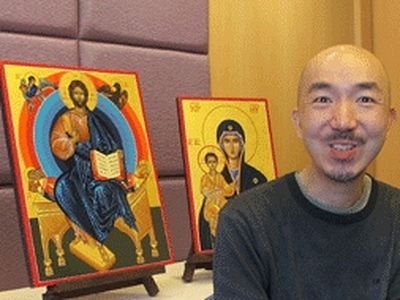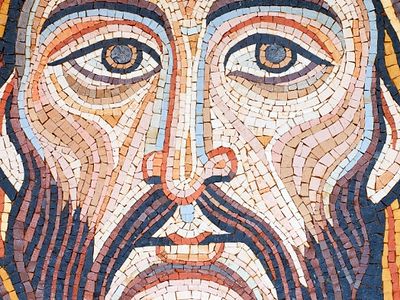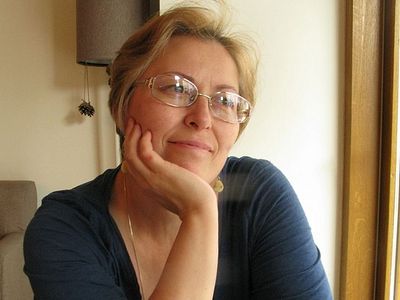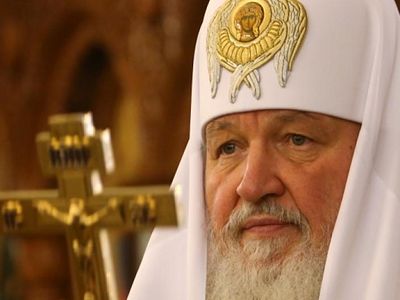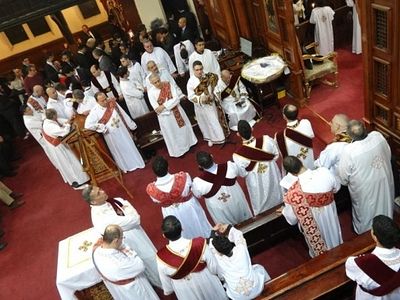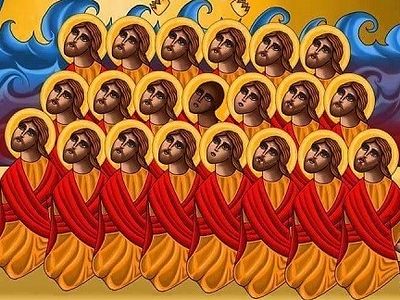Source: National Review
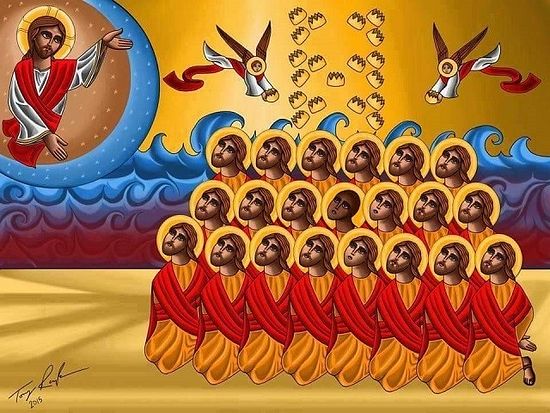
A Coptic icon artist honors the 21 Christian martyrs murdered by ISIS in Libya.
When the Coptic Church announced this weekend that their 21 brothers killed by the Islamic State in Libya had been officially martyred, the iconography already existed. Virginia-area artist Tony Rezk, himself a Copt born in Egypt, had already paid tribute. In an interview, Rezk talks about these new martyrs, his faith, and his art. – KJL
KATHRYN JEAN LOPEZ: What was your purpose and intention when you painted an icon of the Egyptian Copts martyred last week by the Islamic State?
TONY REZK: My ultimate purpose was to honor them and the sacrifice that they made. Tertullian, a Christian apologist from the third century, before he joined a non-Orthodox Christian sect, said, “The blood of martyrs is the seed of the Church.” We believe that their martyrdom will help the Church grow stronger. My other purpose was to take out my frustrations on something, as I find that the process of making any kind of art is a relaxing experience.
LOPEZ: You offer the icon for anyone’s use. Would you or the Coptic Church ever make it available for purchase? Perhaps to raise funds for Copts in Egypt or other persecuted Christians?
REZK: It is actually in the hands of the Coptic Church in Egypt now. His Grace Bishop Macarius has the high-resolution picture and was given permission to do what he wanted with it. His Grace is the bishop of the El Minya province in Upper Egypt where most of the martyrs were from. I’m still trying to figure out a way to get it out there for all to use.
LOPEZ: Why were you so clearly moved by their deaths?
REZK: Because we are taught that we are all One Body of Christ. “And if one member suffers, all the members suffer with it; or if one member is honored, all the members rejoice with it” (1 Corinthians 12:2). Also, if the video didn’t move me, then I couldn’t be a human being. I saw the video of the Jordanian pilot and I just couldn’t take it; this, however, was a mass execution meant to glorify the grisly murders.
LOPEZ: Do you feel a responsibility to them? If so, how?
REZK: All of us in the Coptic community do feel a responsibility to them. First, to pray for them and their families. Second, to help support their families, who are dirt poor and living in one the poorest areas in Egypt.
LOPEZ: Have you been reading up on these martyred men? What strikes you most about them? Is there any story in particular that you find particularly important to highlight?
REZK: I have been reading up on as much as I can, but only in English, since I can’t read Arabic. What strikes me the most was that they loved their families so much that they would risk their lives in order to provide for them. The story of Tawadros Yousef, who has three children, was really hard on me. His brother even went on TV and said that his whole family forgives the murderers!
LOPEZ: What has the reaction in your home church been like?
REZK: We are all in a state of shock from the grisly murders. But martyrdom has been a part of Coptic history and tradition, so it doesn’t defeat us. I believe it only makes us stronger.
LOPEZ: What does it mean to a Coptic Christian to know the threat Copts face? Even this far away from where the 21 died?
REZK: As I said earlier, martyrdom is huge in the Coptic tradition and history. Tertullian also said, “If the martyrs of the whole world were put on one arm of the balance and the martyrs of Egypt on the other, the balance would tilt in favor of the Egyptians.” Martyrdom doesn’t shake us, it only helps us be diligent in our faith.
LOPEZ: You wrote about forgiving these men, forgiving enemies. Is that really possible?
REZK: With Christ, all things are possible. If Christ can forgive those who had crucified him, then who am I to refuse forgiveness to anyone? In the blog post that I wrote I quoted some of the Church Fathers who mention that to forgive someone is to be free from of all hatred, anger, passions, so that we can live in peace, as St. Paul commanded us. (“If it is possible, as far as it depends on you, live at peace with everyone.” — Romans 12:18.) We also can’t have hate in our hearts and say we love God — it contradicts what God stands for, since Saint John said that God is Love. We can’t hope to be like Christ if we have hate in our hearts.
LOPEZ: What do you wish more people knew about the Coptic Church?
REZK: I’m so glad that you asked me this question. I meet a lot of people online who think that Copts are monophysite heretics. They think we believe that Christ’s humanity was swallowed up in his divinity, or that we confuse the natures, hence our use of the christological terminology of “One Nature,” but that couldn’t be any further from the truth. We follow the christology of Saint Cyril of Alexandria, whose terminology was “One [mia] Nature of the Word of God Incarnate.” In this we believe that Christ’s full humanity and his full divinity are untied, without confusion, mixture, separation, or alteration. He remains perfect Man and perfect God always. Saint Cyril used this terminology because he was combating the teachings of Nestorius, who believed that Christ existed “in two natures.” Nestor divided Christ’s nature and did not believe in a hypostatic union. It was definitely a messy time of Christian history. But we are miaphysites and not monophysites. We also have had a long history in Egypt, since the time of Saint Mark, who established the Church of Alexandria. The early Church of Alexandria presented three things to the Christian world: theology, martyrdom, and monasticism.
LOPEZ: What do you wish more people knew about Christianity in Egypt?
REZK: That we are a spiritual church that has its roots in the teachings of Christ and the apostles.
LOPEZ: Do you see any good coming out of the deaths of these 21? Are Christians coming together?
REZK: I have seen an outpouring of support from many different Christians: Catholics, Eastern Orthodox, and Protestants. It’s been overwhelming, actually. I pray that their deaths will be the seed for true unity within the Church.
LOPEZ: Is iconography what you do? Is there a market in it much beyond Eastern churches?
REZK: Yes. I do digital icons, meaning I use a computer to produce my works. I’m passionate about it because I think in the West icons are frowned upon because of a misconception that those who use icons are worshiping them and are idolaters. In reality, icons are supposed to be windows to heaven; they tell us a story, and their theological implications are huge. You could touch, speak to — and my generation might very well take selfies with — a truly incarnate Christ if he were walking the earth today. This is why icons are important: because God took true flesh and became one of us, and thus we can depict God in icons — the closest we can get to a photograph. I think that if this is properly understood, there can be a market for icons in the West, but it’s not about making money. It’s more about teaching what the Church has always believed about icons. I have been overwhelmed by the different Christian denominations that have expressed interest in the icon of the 21 martyrs: Catholics, Orthodox, and even Protestants. It’s been an overwhelming experience.
LOPEZ: What got you interested in art?
REZK: Now more than ever, I’m interested in Coptic (Egyptian) art. However, when I was younger I was more interested in the realism of Renaissance and Western art. One of my favorite periods was also that of the Chiaroscuro style, which had deep contrasts between light and dark. I absolutely loved the brilliant works of Peter Paul Rubens and Caravaggio. I also like the Baroque style, which encouraged motion. In general, I like art that tells a story and encourages motion, one that isn’t fixated or rigid. Thus, I try to have motion in my icons.
LOPEZ: What do you hope to do in your career as an artist?
REZK: I hope to be able to make icons for churches via a digital means. However, the way that I do them is not traditional. Though my icon has been well received in the church thus far, I’m personally not sure if my artistic method will be, because behind the traditional painting of an icon there is a theology that is lost with the digital method.
LOPEZ: Your blog has posts about Athanasius of Alexandria, Saint Macarius, and others. Who is your favorite saint and why?
REZK: It’s hard to pick just one, so I will pick two, if you don’t mind. The first is Saint Athanasius of Alexandria, whom I greatly admire. Athanasius was our patriarch for about 40 years, and he never gave in to the demands of the Arians, who denied the true divinity of Christ. He is a hero of mine because it almost seemed like he was the last bishop in the Roman Empire who held on to the true teachings of the apostles. Fun fact: Saint Athanasius is recognized as the first Christian to have listed all 27 books that we use in the New Testament today. My second favorite is the late patriarch of Alexandria, Saint Pope Kyrillos (Cyril) VI. He was our patriarch from 1959 to 1571 and is one of the greatest saints the Coptic Church has ever produced. My parents’ generation can attest to his holiness (God wants us to be holy and to be saints) and his miraculous life. He was an extremely spiritual man whose life was full of prayer. There are many books that document miracles by Pope Kyrillos VI. If you were to ask me to be a disciple of any two men from history, I would be their disciples, learning my theology from Saint Athanasius and my spirituality from Saint Kyrillos VI.
LOPEZ: Why do you blog? Why title your blog “Contra Mundum”?
REZK: I’m not that good of a writer, but I blog to share things I learn. I titled it “Contra Mundum,” which is Latin for “against the world,” because that is what Saint Athanasius himself said. He was in a sense against the world, which at the time had fallen into the Arian heresy. Not the world of people, because we believe God made the world good, but the world of erroneous beliefs. I know we live in a very politically correct era in which everyone is offended by every little word. But I think it is important to be able to judge ideas without judging people.
Kathryn Jean Lopez is senior fellow at the National Review Institute, editor-at-large of National Review Online, and founding director of Catholic Voices USA.
